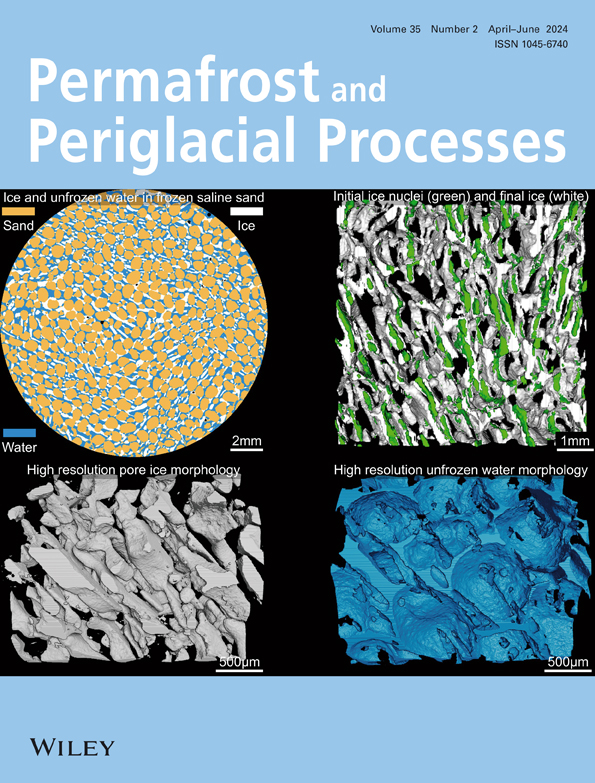Last Glacial Maximum cryogenic calcite deposits in an alluvial fan at Villetoureix, southwest France
IF 3.3
3区 地球科学
Q2 GEOGRAPHY, PHYSICAL
引用次数: 0
Abstract
The origin of white calcite silts forming 0.5 to 3‐cm‐thick lenses in alluvial fan deposits 14C‐dated to the Last Glacial Maximum in the Dronne Valley (Dordogne, southwest France) is investigated using microscopic imagery, chemistry, and O and C stable isotopes. The calcite silts, composed mainly of aggregates of 3–5‐μm euhedral crystals, do not resemble secondary precipitations of pedological origin because of the strata‐like pattern and the lack of clearly identifiable biological structures. Their association with evidence of ice formation in the soil (platy structure, involutions) suggests that they were deposited in a deep seasonal frost context. Their isotopic composition differs significantly from those of detrital carbonates and of Holocene bioprecipitation and seems to be best explained by precipitation under closed‐system conditions. Calculation of the isotopic composition of calcite that would have formed in equilibrium with groundwater of regional LGM aquifers provides values that are in the range of the composition of the calcite silts for a precipitation temperature close to 0°C. Therefore, these deposits are interpreted as cryogenic calcite precipitated from waters close to saturation with respect to calcite freezing at the base of/within icings or within the ground, possibly from frost blisters. Similar calcite precipitation at the outlet of karstic springs may have been abundant in the calcareous terrains of southwest France during the LGM, although still unrecognized in the geological record.末次冰期极大期的低温方解石沉积在法国西南部Villetoureix的冲积扇
利用显微图像、化学和O和C稳定同位素研究了法国西南部多格涅(Dordogne)德龙河谷(Dronne Valley)末次盛冰期(Last Glacial Maximum) 14C冲积扇沉积物中形成0.5至3cm厚透镜体的白色方解石粉砾的起源。方解石粉砂主要由3-5 μm的自面体晶体组成,由于其类似地层的模式和缺乏清晰可识别的生物结构,不像土壤成因的次生降水。它们与土壤中冰形成的证据(板状结构、卷积)相关联,表明它们是在深季节性霜冻环境中沉积的。它们的同位素组成与碎屑碳酸盐和全新世生物沉淀物的同位素组成明显不同,似乎可以用封闭系统条件下的沉淀物来最好地解释。对方解石同位素组成的计算表明,当降水温度接近0°C时,方解石粉砂的组成范围与区域LGM含水层的地下水平衡形成。因此,这些沉积物被解释为从接近饱和的水中析出的低温方解石,相对于方解石在冰冠底部/内部或地下冻结,可能来自冰疱。在LGM时期,法国西南部的钙质地形中,喀斯特泉出口处可能也有类似的方解石降水,尽管在地质记录中尚未得到确认。
本文章由计算机程序翻译,如有差异,请以英文原文为准。
求助全文
约1分钟内获得全文
求助全文
来源期刊
CiteScore
9.70
自引率
8.00%
发文量
43
审稿时长
>12 weeks
期刊介绍:
Permafrost and Periglacial Processes is an international journal dedicated to the rapid publication of scientific and technical papers concerned with earth surface cryogenic processes, landforms and sediments present in a variety of (Sub) Arctic, Antarctic and High Mountain environments. It provides an efficient vehicle of communication amongst those with an interest in the cold, non-glacial geosciences. The focus is on (1) original research based on geomorphological, hydrological, sedimentological, geotechnical and engineering aspects of these areas and (2) original research carried out upon relict features where the objective has been to reconstruct the nature of the processes and/or palaeoenvironments which gave rise to these features, as opposed to purely stratigraphical considerations. The journal also publishes short communications, reviews, discussions and book reviews. The high scientific standard, interdisciplinary character and worldwide representation of PPP are maintained by regional editorial support and a rigorous refereeing system.

 求助内容:
求助内容: 应助结果提醒方式:
应助结果提醒方式:


